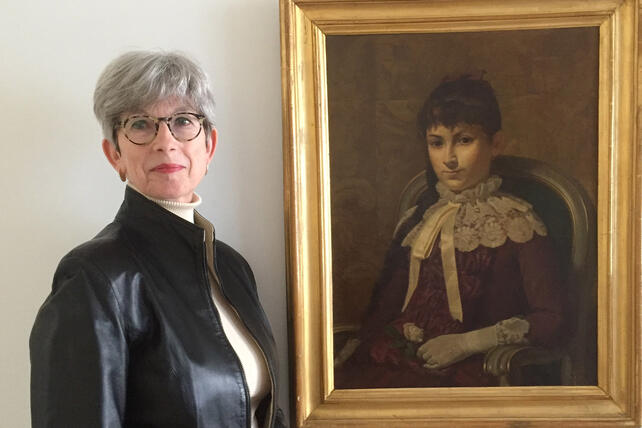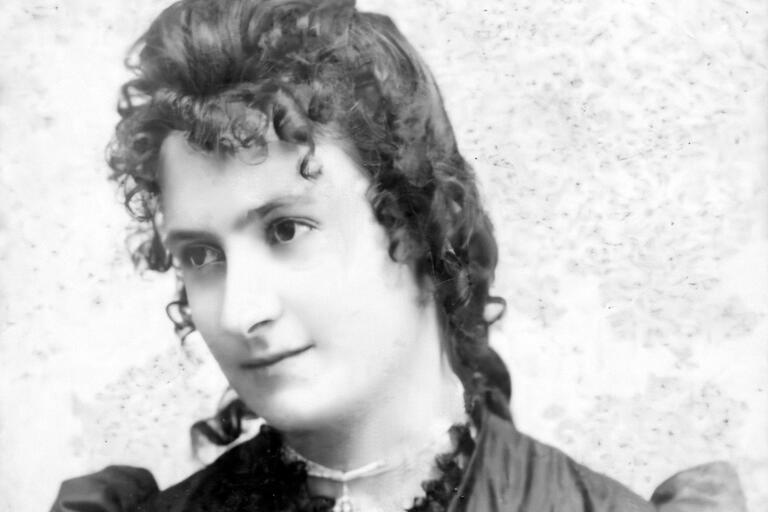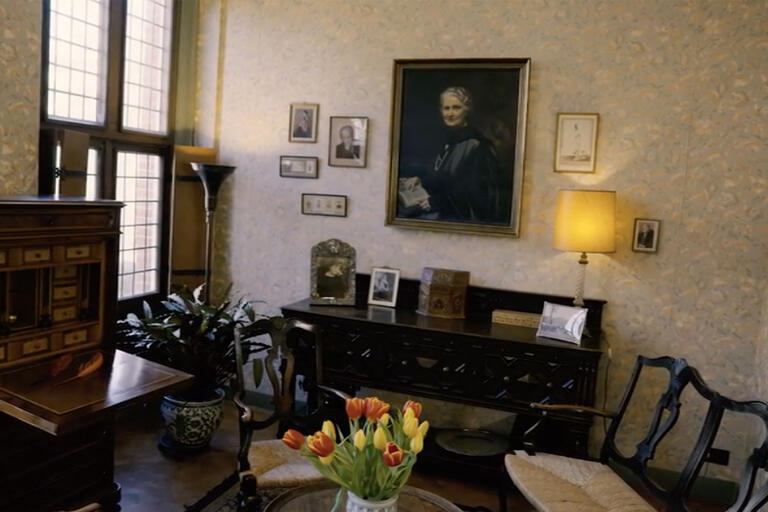Helen Henny Gifts Painting of Maria Montessori Aged 13
The 2019 AGM was AMI's 90th birthday and was also a "curtain raiser" to 2020 when the world will celebrate 150 years since the birth of Maria Montessori in 1870.
Helen Henny, great-granddaughter of Maria Montessori, entrusted to AMI's care the oil painting of the young Maria at age 13. Many of our community may be familiar with the black and white reproduction included in various biographies, but nothing compares with the warm colours of the original. This rare painting will be given a prominent place in Maria Montessori's study, here in Amsterdam, and will be available for all who visit Maria's study to see for themselves. Helen's was an incredible gesture, and AMI is deeply honoured.
We are also delighted to be able to share the personal and insightful speech Helen gave to the participants of the AGM.
Hello everyone, hello Montessorians,
My name is Helen, called after my grandmother Helen Christy, the first wife of Mario Montessori and the mother of his four children.
I am the daughter of Maria Elena Adelia Pace Montessori—Marilena for short—Mario’s firstborn and Maria Montessori’s first grandchild.
So amazed and happy was the Montessori family with the arrival of this first child, this miracle, that they put her in a basket full of flowers and set her in the middle of the dining room table as a centrepiece. Imagine the surprise of visitors who all of a sudden would hear little gurgling sounds coming from among the flowers and foliage.
Maria, or Mammolina as we in the family call her, was of enormous influence on the lives of Mario, his wife and their four children. And through them on the lives of us, her great-grandchildren.
In a sense she had quite a direct influence on the start of my life.
My mother—who was not a religious person—always told me that if she had to believe in something, it would be in reincarnation, because that was the only belief system that made any sense of the enormous unfairness and inequality that existed in the world. When she was expecting me, two years after Mammolina died, I was due on the 31st of August, which is— as most of you will know—the very birthday of Maria Montessori. My mother panicked.
As she later guiltily admitted: “I pushed you out prematurely. You were not completely finished when you were born. You did not have any eyelashes yet!”
As a child you take these stories for granted, but when I was older, I asked her why she had felt the need to do this. She answered: “I was so scared you’d be a reincarnation of Mammolina.” This I did not understand. Why would that be such a bad thing? “Because,”she said, “You would have become a genius”—that did not seem such a problem to me either. But, she continued: “And geniuses are lonely. In their mind they are so far ahead of their time, they operate on such a different plane of thinking, that they can hardly find anyone of the same intellectual level, the same understanding. And that makes them lonely. So, I did not want you to become a genius, I wanted you to become a happy and normal person.”
Well, all’s well that ends well: I most certainly did not become a genius. My eyelashes grew eventually and well, as far as normal goes … that is up to others to decide!
Mammolina, my mother recalls in her memoirs, was the centre of their universe. As her son Mario had chosen to dedicate his life to her and her work, and with her being an Italian Nonna, she lived with her son and his family.
She was the reason that my mother would call herself Italian, even though she, her brother Mario and sister Renilde were born in Barcelona and the siblings grew up in several different countries, as a result of the moves the family made in response to the political situation or Mammolina’s work. In the end my mother spoke Spanish with her brother Mario and sister Renilde, English with her mother and youngest brother Rolando, and Italian with her father and grandmother. And, of course, Dutch with us by the time she had married my father, Jan Henny, and became a mother herself.
Mammolina’s presence dominated their lives, in the practical, the cognitive and the emotional sense.
When she prepared for a lecture she would sit for hours on end at her semi-oval table in the family’s dining room, a gold-tipped cigarette in the corner of her mouth, squinting through the smoke at her small playing cards through endless games of Solitaire, while ruminating on which thoughts to stress, which theorem to advance. Then she would go up to her study and put her thoughts down on paper, pages and pages and pages covered with her elegant handwriting. Later she would read bits and pieces aloud to the family, ask for their thoughts, their reactions, what it had conveyed to them. Then she would rewrite, simplify, ameliorate.
Before a lecture the whole house would reverberate with her nerves. What to wear? Which gown, scarf, shawl, hat, gloves? Her appearance was always meticulous and elegant. This her mother Renilde had always stressed. And it did not go unnoticed:
A Dutch journalist—a man most probably—who reported for the Java Bode on her contribution at the International Feminist Congress in Berlin in September 1896 recounted nothing of her speech, the content of what she had come to say. He only exaltedly and jubilantly cheered the Italian beauty of this “fiery red little socialist”, her dark braids and sparkling dark eyes, her elegant appearance and filled out forms, the sweet music of her tongue, etc. etc.
Emancipation still had a long way to go. (And still does…)
Once arrived at the lecture hall, Mammolina would sit quietly throughout introductions and preliminaries, fiddling with her gloves, opening and shutting her handbag, turning the stem of the rose her son Mario always gave her before a speech or a lecture.
And then, when her turn came, she got up and all nervousness and incertitude dropped from her as she began to speak in her resonant, clear voice. Often as not on a completely different subject from the one she had prepared with such diligence. She never read from a paper.
Except once, as my mother recalls…
The two oldest grandchildren were expected to accompany her to her lectures and speeches and form an opinion about them. So my mother remembers being present, at age eleven, at a particularly stately and official event at the end or beginning of a course. Speakers were members of Parliament, eminent Professors and other Prominent Persons, and they all read Impressive Speeches from Impressive Papers. My mother noticed that, while bored yet patiently sitting through all of it, Mammolina was getting fidgety, perhaps a little agitated: obviously, something disturbed her. She was nervously searching in her handbag for something. The sense of relief showed on her face when she had at last found what she had been looking for: a small piece of paper. When her turn came—the last of the speakers—she went to the rostrum and started speaking, diffidently at first, carefully consulting her piece of paper. As her speech progressed, she straightened and spoke with more and more confidence and enthusiasm. And as she inspired and enthralled her audience more and more, the person next to her could’nt resist taking a peak on the piece of paper she was still holding in her hand: to her astonishment it was blank! There was nothing written on it!
It turned out that Mammolina had felt shy at being the only speaker present who hadn't written down her speech!
But apart from being an exceptional scientist and feminist, a woman who also in her last years while living on Koninginneweg continued to work—still with a cigarette in her mouth— Mammolina also loved food, and its preparation with the whole family; one of her favourite dishes was potato gnocchi, quite a gruelling job to make! For relaxation purposes she read detective stories— in her opinion the only acceptable books to read besides scientific tomes and articles. She loved playing games and had to win at them! Which the family let her! Or she took Mario and Marilena for binge-watching sessions in the movie theatre: 4 movies in a row. In the middle of which she, of course, would fell asleep, and on waking up would suddenly say out loud: “Who is that man? What’s he doing?” To the embarrassment of her grandchildren.
The famous scientist, Dottoressa Montessori, once was a child, an adolescent herself. A 13-year-old girl I came to know so well in a sense. I sat opposite her at our dining room table and we exchanged glances for hours on end during formal dinner parties, birthday dinners, and family gatherings. Our dining room table more often than not seated twelve. And as I was the youngest in our family, I did not have that much to add to the conversations of the grown-ups and so we gazed at each other a lot, the young Maria and I. She sat quite straight, her fringe covering her forehead, her long dark hair pulled together with a red bow. Her left gloved and dainty hand holding a rose in her lap. And her eyes, dark and inquisitive.
From the meticulous notes her father Alessandro made of his daughter Maria, as she grew up, and from the notes she herself took during that period, we know she was only about 1,47 meters tall at the time. She was not particularly good at school and not very interested either. Instead of listening to her teachers, she would dream up little games and plays. In 1884 she went to the technical school for girls Regia Scuola Tecnica Buonarroti. But according to her father she mainly hung out with her friends and showed no real ambition whatsoever. Yes, she took piano lessons and acting lessons and even dreamed of becoming an actress. When, after one of her performances, she was complimented profusely by her friends and her teacher on her excellent performance, she all of a sudden “saw the light”. She realised this was not to be her future, she had more important things to do. And from this moment on, she really started studying, concentrating on languages at first and later also on maths.
She wanted to become a teacher and go to the Teacher Training College for women. Alas, the Ministry of Education did not recognise her diploma as adequate for entrance to this school. And so she decided to go instead to the Istituto Tecnico Maschile Leonardo Da Vinci—a technical school for boys—with the intention of becoming an engineer.
This seems to be the first door of the Parable of “the closing doors”. As Mammolina later in her life explained to my mother through this parable: she had not chosen her path, her destiny, she had been chosen, she had been driven by doors that closed for her and forced her to make another choice, take another route.
Being a child then, my mother pictured her grandmother, eager to enrol herself at the university, hastening to the piazza where the university building stood, in order to enrol herself in the study of engineering. But on finding the door closed, she tried the other door of the building, it being the entrance to the faculty of medicine. And the rest is history.
But the Maria of 1883, my silent companion at our dining room table, was still a girl who did not yet know what she wanted in life. The future lay open before her. She did not yet realise that through “the closing of doors” —as she put it—she would be driven to the important work she eventually took up for the benefit of children, of humanity and of the world.
A work that all of you here have taken over in order to spread it throughout the world, a work to which you dedicate your time, your energy, your lives. A work that is needed now more than ever—although I realise that each generation probably thinks the same: now more than ever.
I stand here with respect and admiration for the work you all do.
I stand here in memory of my mother Marilena, whose centennial it will be on the 16th of June.
I stand here in celebration of the 90th anniversary of AMI.
I stand here because I have come to realise that the young Maria of 1883 belongs to you as much as to me.
So I wish to present and to donate to you, through AMI, the portrait of Maria Montessori, 13 years old, painted by the painter A. Berrini in Rome in 1883.
Thank you.
Helen Henny
*With thanks to my late mother M.E.A.P. Henny-Montessori, and my cousins C. Hussein-Montessori and A. Visser-Montessori for their input.






